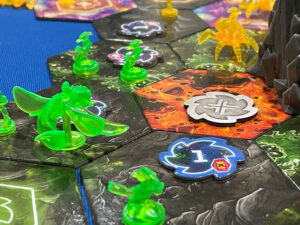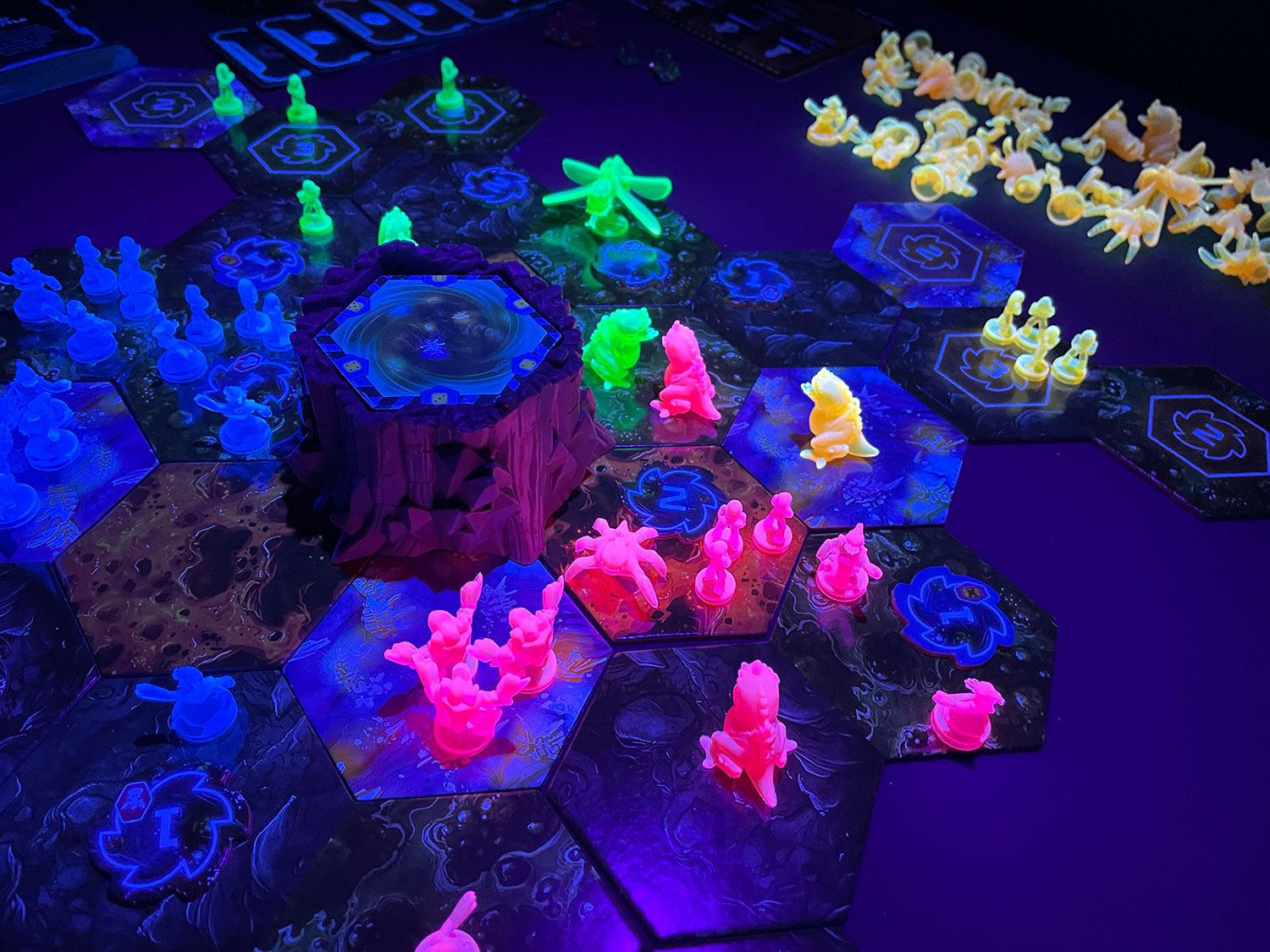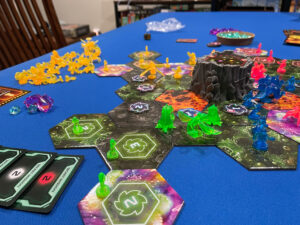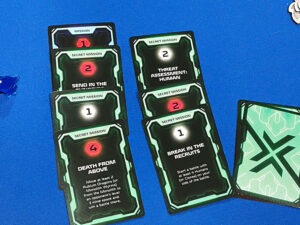 Step into the time machine. That’s it. Get comfortable. The coordinates are all set for 2005. This trip is traveling to the late dark ages of board gaming, just before the beginning of the golden age. Catan was slowly climbing in popularity in the USA. Carcassonne was only five years old. Even the Ticket to Ride saga was only on its second title and much of the board gaming lingo was still discussing American vs Euro games (still is in some places).
Step into the time machine. That’s it. Get comfortable. The coordinates are all set for 2005. This trip is traveling to the late dark ages of board gaming, just before the beginning of the golden age. Catan was slowly climbing in popularity in the USA. Carcassonne was only five years old. Even the Ticket to Ride saga was only on its second title and much of the board gaming lingo was still discussing American vs Euro games (still is in some places).
The reason this reviewer points this out is that you have to understand the general scope of what board games were at this time to understand the rating for Nexus Ops, a 2005 title from (originally) Avalon Hill, then Fantasy Flight Games (pre-Asmodee purchase), and now Renegade Game Studios. It’s a light wargame with dice combat resolution…
Ok, settle down. There’s no need to reach for that browser button. There are still some modern games that enjoy this mechanism and do quite well with it. This reviewer may just sway you, dear reader, to reconsider this gaming trope and acknowledge that some games do it well. With the right game and the right friends, the premise this game provides will fire on all cylinders. So, stay awhile and hopefully the information below will help give you a more informed perspective.
Oh, and just to get back to the previous point, this light wargame with dice combat works for 2-4 players and has a mild 90-minute playtime. It’s definitely recommended for 4 players if you can.
Gameplay Overview:
Ok, so the rules say:
“In the year 2315, space explorers discover a moon in a remote planetary system. There they stumble upon Rubium, a rare and valuable energy source. The explorers sell the moon’s location to immoral and competitive galactic corporations, Ares Inc., Black Helix Industries, The Galactic Syndicate, and Zyborg Technologies. Each send a strike force…”
Ok, ok. It’s space. There’s weird creatures you can deploy. There’s a large hex based map with different hex types and a cool central hex. All the units have a special thing or ability, and there are even two game modes with a completely different set of unit abilities to try out. As for play structure, each player takes a turn going through a series of phases:

1. Purchase and Deploy new units.
2. Move units.
3. Explore (if you’re on a tile with an Exploration token you might discover a mine or bonus unit).
4. Fight for 1 combat round only.
5. Income for the mines (certain tiles) you control.
6. Draw 1 Secret Mission card which is worth VP if you complete it. If you control the central Monolith, draw 2 Energize cards (they’re like special power cards).
Play continues around the table until the game ends. This is pretty standard but readers should notice the single round of combat. This makes the game a lot smoother and it also means disrupted hexes (occupied by 2 or more players) do not produce income. In addition, a player may control a hex with a mine, but may not have the needed type of unit in the hex in order to mine it.
On the other hand, the more welcome wargame conceit is that certain units attack/fire before others. The order of combat means that weaker units will likely be cannon fodder since the player receiving damage decides unit destruction for combat. However, these are also the units that are used for mining. And, of course, the cost of units goes up as they have more and better attack powers. Big units need supporting units to stay alive long enough to accomplish the big plays expected of them.
The game is ultimately decided by victory points (VP) gained from combat and Secret Missions. If a player doesn’t have a Secret Mission card that matches a battle’s conditions, they gain a single VP. If, however, the Secret Mission card is relevant, the player plays it and gains between 2-5 VP. Players may play to whatever total works for them (higher = longer game) but the rules suggest a 10, 12, or 14 VP total to immediately win the game.
There are also many optional rules and different board layouts to help players get started.

Game Experience:
If you, dear reader, are still with this reviewer, you’ll see some things stacking up in the positive column. Don’t make the assumption that this game is anything more than it is, and you and your group will have a good time blasting away opponents, negotiating around the table, and hovering over the table looking for those opportunities to complete Secret Missions, which is really the fastest way to gain points. For those looking for more, there are plenty of optional rules and many more online from the cult of players following this game over the years. Overall, it’s a quintessential light wargame.

This reviewer’s background with similar wargames comes from playing 1980s Axis & Allies, Shogun (now Samurai Swords), RISK 2210 (2001), and a personal favorite Fantasy Flight Games release called Dust (2007) with a unique post-WWII meets alien tech theme. Dice combat works for these titles as long as you don’t take the games too seriously. The influence from RISK 2210 is evident in Nexus Ops, and, overall, it’s an excellent game to introduce to new gamers or those who need a lighter escape from heavier calculation games.
With this production, there are a couple of issues that will either really bother newcomers or just fade into “coulda/shoulda” missed opportunities. The first is that the very cool looking central hex tile monolith is so tall it blocks the view of any units directly across from it. It’s a big plastic piece reminiscent of Devil’s Tower or Uluru from down under. It gives a nice 3D effect to the board, but it can also require players to stand up if they have units behind it resulting in a bit of a telegraph of a player’s plans.

Now, the other aspect of this production is that all the pieces are made of a special type of plastic that glows brighter under blacklight (see pics). Unfortunately, some of these pieces are very small. The pictures here were made with a blacklight flashlight shining right on the pieces from overhead. If you purchase the game and want the same effect, you’re going to want to install overhead blacklights and then be sure there is still enough ambient light to see cards and the reference materials on the table. All of this may take a bit of work for enjoyment of just THIS game.
With the first production of Nexus Ops, this was an interesting selling feature of the game, and it definitely amps up the game’s toy-factor. However, in practice, beyond taking some cool pics and mild amusement, this reviewer would have rather seen a better game insert. And then again, maybe yours truly is not the target audience for this sort of thing.
Final Thoughts:
If you’re the type of gamer that needs a title for every occasion, and you’re missing a light wargame, this is an easy purchase decision. The easy flow of play, strategy options, and use of Secret Missions to drive tactics all just work. Just be sure that dice combat and the space theme are what you’re looking for. If either of those are not your style, keep looking. If you’re just a fan of light wargames, definitely pick this up. For the value in the box, Nexus Ops boasts a very competitive offering even if the glow-in-the-blacklight minis can only shine for an Instagram moment.
Final Score: 4 Stars – Light wargaming with interesting glowing units and quick but enjoyable strategy.
 Hits:
Hits:
• Victory point system drives the game well
• Units are not all cookie cutter and require some analysis
• Easy to learn
Misses:
• Glow in the blacklight units are cool but unnecessary
• Units are a little too small
Disclosure: Someone who works with Renegade Games also writes for Board Game Quest. He had no influence over the opinions expressed in this review.





















